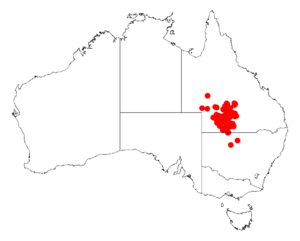Acacia petraea facts for kids
Quick facts for kids Lancewood |
|
|---|---|
| Conservation status | |
| Scientific classification | |
| Genus: |
Acacia
|
| Species: |
petraea
|
 |
|
| Occurrence data from AVH | |
Acacia petraea, commonly known as lancewood, is a type of shrub or tree. It belongs to the Acacia genus, which is a large group of plants. This plant is native to the north-eastern parts of Australia.
Contents
About the Lancewood Plant
What Does Lancewood Look Like?
The lancewood plant can grow quite tall, reaching up to about 10 meters (around 33 feet) high. It has bark that is grey-brown and looks like long strings. Its younger branches are yellowish-brown to purplish-brown and might have a few hairs, but they become smooth as they get older.
Instead of regular leaves, lancewood has special structures called phyllodes. These phyllodes are tough and stay green all year round. They are long and narrow, usually straight or slightly curved. They can be between 13.5 to 26 centimeters (about 5 to 10 inches) long and 2 to 6 millimeters (less than an inch) wide. Each phyllode tapers to a point and has many tiny lines running along it.
When Does Lancewood Bloom?
Lancewood plants produce beautiful golden flowers. They usually bloom between May and September.
Where Does Lancewood Grow?
Lancewood is a plant that is endemic to a specific area. This means it only grows naturally in certain parts of south-western Queensland, Australia. You can often find it on or near the Grey Range.
It likes to grow in rocky soils, especially on rocky slopes and the tops of ridges. It is part of different plant communities, such as savannah (grasslands with scattered trees), heathlands, or open woodlands. The areas where lancewood grows are sometimes spread out, with smaller groups of plants found in other districts like Gregory South and Warrego, and even close to the border with New South Wales.
How Lancewood Got Its Name
The second part of the lancewood's scientific name, petraea, comes from a Latin word. It refers to the rocky places where this plant is often found growing. This name was given by a botanist named Leslie Pedley.
Images for kids



